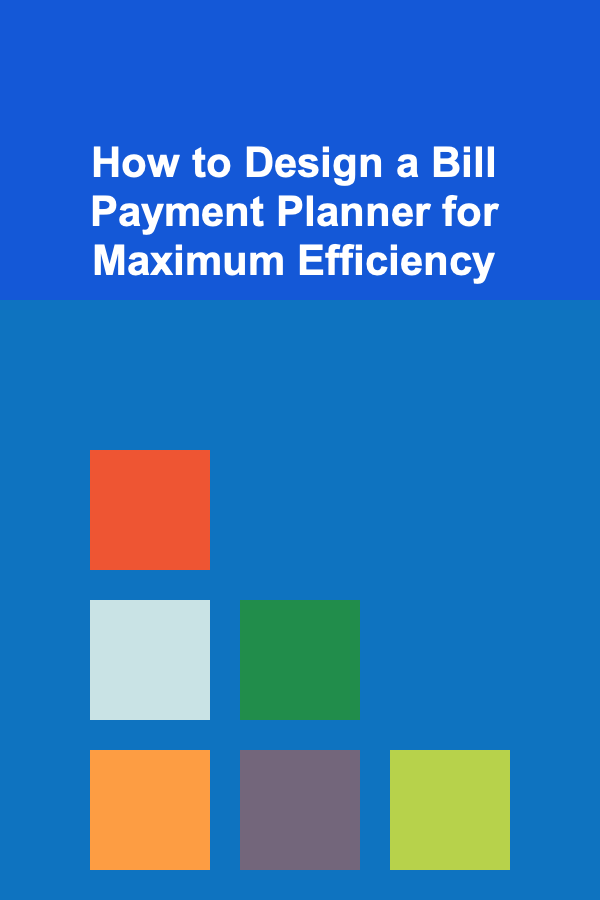
How to Design a Bill Payment Planner for Maximum Efficiency
ebook include PDF & Audio bundle (Micro Guide)
$12.99$7.99
Limited Time Offer! Order within the next:

Managing bills and finances is a fundamental aspect of personal financial health, but it can also be a source of stress and confusion if not properly managed. Many people struggle with keeping track of due dates, remembering which bills to pay, and ensuring they have enough funds to cover all their expenses. One of the most effective ways to alleviate these concerns is by designing a bill payment planner that not only helps manage your finances but also maximizes your efficiency and mental clarity.
In this article, we'll explore how to design a bill payment planner that suits your lifestyle, minimizes late payments, and maximizes financial efficiency. We'll cover everything from understanding your financial obligations to organizing payment methods, creating a reliable payment schedule, and tracking your progress toward financial goals. By the end of this guide, you'll have a practical and effective system to manage your bills with ease.
Understand Your Financial Obligations
The first step in designing an efficient bill payment planner is understanding exactly what bills you need to pay. Without a clear overview of your financial obligations, it's easy to miss payments, forget deadlines, or overextend your budget. This foundational step will guide all other decisions in your planner design.
Make a Comprehensive List of Bills
Start by listing all your bills, categorizing them into fixed and variable expenses. Fixed expenses include regular, predictable costs such as rent or mortgage, utilities, insurance premiums, and loan payments. Variable expenses might include groceries, credit card payments, entertainment, and discretionary purchases, which can fluctuate each month.
- Fixed Expenses: Rent, mortgage, insurance, car payments, subscriptions (e.g., Netflix, gym), loans.
- Variable Expenses: Utilities (water, electricity, gas), groceries, phone bill, entertainment, unexpected medical expenses, etc.
Include Payment Dates and Amounts
For each bill, include the following details:
- Payment Amount: The amount you need to pay each billing cycle (monthly, quarterly, yearly).
- Due Date: The date by which the payment must be made.
- Billing Cycle: Whether the bill is monthly, quarterly, or annual.
- Payment Method: Whether the bill is paid automatically, by check, online, or through another method.
This list forms the backbone of your bill payment planner and helps you keep track of every financial obligation.
Choose a Format for Your Bill Payment Planner
The next step is deciding on the format of your bill payment planner. Depending on your personal preference and lifestyle, this can be done digitally, on paper, or even in a hybrid form.
Digital Planner
A digital planner can be very efficient and convenient for those who are constantly on the go. You can use apps like Google Calendar, Notion, or specialized bill payment apps like Mint or YNAB (You Need A Budget). Digital planners offer the flexibility of setting automatic reminders, syncing across multiple devices, and keeping track of your spending.
- Pros: Can sync with multiple devices, easily updated, automatic reminders, and track payments directly.
- Cons: Requires internet access and digital literacy.
Paper Planner
For those who prefer a tactile approach, a paper planner can be a great option. You can use a simple notebook or a specialized bill planner, where you write down your bills, due dates, amounts, and payment status.
- Pros: Hands-on, no technology required, can be easier to visualize for some people.
- Cons: No automatic reminders, easy to lose or misplace, and can become disorganized without a consistent routine.
Hybrid System
A hybrid system combines the best of both worlds. For instance, you can use a digital planner for tracking payments and due dates but maintain a paper-based list for a physical overview. This combination can offer flexibility and ease of use.
- Pros: Flexibility of both digital and paper-based methods.
- Cons: Requires maintaining both systems.
Choose a system that suits your habits, and make sure it's something you can consistently use to track your bills effectively.
Create a Payment Schedule
Having a payment schedule is critical for managing your bills efficiently. A payment schedule allows you to anticipate when payments are due, plan ahead, and avoid late fees or financial strain. It is essential to align your payment dates with your income cycle.
Align Payments with Income
Many people get paid bi-weekly or monthly. To maximize efficiency, align your bill payments with your income cycle. For instance:
- If you get paid bi-weekly, allocate part of each paycheck to pay specific bills (e.g., rent or utilities).
- If you get paid monthly, set up automatic payments for bills that occur monthly and plan for larger bills like insurance and loan payments.
Set Up Payment Reminders
Once your payment schedule is set, ensure that you set reminders for each bill. You can use digital calendar reminders or physical sticky notes placed in visible areas. The goal is to ensure that you never miss a payment due date.
You can also automate payments for bills that offer this option, such as utilities, subscriptions, and insurance. Automation reduces the chances of forgetting to make a payment.
Track Your Bill Payments
The next critical step is setting up a system to track your bill payments. This step ensures you never miss a payment and also helps in tracking your spending over time. You can set up a simple tracking sheet, a digital dashboard, or a specific app to keep track of when you've paid each bill.
Use a Payment Tracker
If you are using a digital planner, apps like Mint and YNAB offer features to track your payments and provide an overview of your financial situation. If you prefer a paper method, create a chart or table with columns for:
- Bill Name
- Amount Due
- Due Date
- Amount Paid
- Payment Status (paid or pending)
For each bill, mark off when it has been paid and keep a record of the payment amount. This will help ensure you stay on top of your finances and give you a clear picture of what has been taken care of.
Implement Financial Buffering
One of the most efficient ways to ensure your bills are paid on time without financial stress is to implement a buffer system. Having a buffer means that you are always prepared for any unexpected costs or fluctuations in your bills.
Build an Emergency Fund
An emergency fund is a safety net that ensures you can handle unexpected expenses, such as a sudden medical bill or car repair. Ideally, this fund should cover 3-6 months of expenses. As part of your bill payment planner, allocate a portion of your income each month toward building this fund.
Set Aside Funds in Advance
For bills that are paid quarterly or annually, set aside a small portion each month into a separate savings account. This method ensures that you are not caught off guard when these larger payments are due. You can also automate this by setting up automatic transfers to your savings account.
Prioritize Bills
Sometimes, life can get in the way of paying bills on time, whether due to unexpected circumstances or cash flow problems. In these situations, it's important to prioritize your bills.
Identify Non-Negotiable Bills
Prioritize bills that are essential for your basic needs, such as rent or mortgage, utilities, and car payments. These are bills you cannot afford to miss, as they can lead to serious consequences like eviction, loss of service, or repossession.
Manage Discretionary Bills
Next, handle discretionary bills like subscriptions, gym memberships, and entertainment expenses. While these are important, they are not essential to your daily functioning. If necessary, prioritize the essentials and delay or cancel non-essential services until your finances stabilize.
Review and Adjust Your Plan Regularly
A good bill payment planner is not static---it should evolve with your financial situation. Regular reviews will help you stay on track and adapt to any changes in your financial life.
Monthly Check-ins
Set aside time each month to review your bill payment planner. During this check-in, verify that all bills were paid on time, check your tracking sheet for any missed payments, and ensure that your budget is still accurate. Make adjustments as necessary, such as tweaking your payment schedule or re-allocating funds to your emergency fund.
Annual Review
Once a year, do a comprehensive review of your bill payment planner. Look at areas where you can reduce costs, such as by canceling unused subscriptions or renegotiating loan terms. This is also the time to reassess your financial goals and see if there are any new bills to add or old ones to remove.
Leverage Technology for Efficiency
Technology can make bill management much easier and more efficient. Beyond digital planners and trackers, there are other tools that can help you streamline your process and make payments even more convenient.
Set Up Automatic Payments
Most utilities, services, and loan providers offer automatic payment options. If you're certain that your income is steady and predictable, automate your recurring payments. This ensures that your bills are paid on time, every time, without needing to manually manage the process.
Use Bill Management Apps
Many apps, such as Truebill or Prism, are designed specifically for bill tracking. These apps can link directly to your accounts, automatically track due dates, and send reminders when payments are coming up. Some even allow you to pay your bills directly from the app, reducing the need to log into different platforms.
Stay Consistent and Motivated
One of the hardest parts of maintaining a bill payment planner is staying consistent. Life can get busy, and it's easy to fall behind on payments. However, staying on top of your bill payments is key to financial stability and peace of mind.
Create Positive Habits
Incorporate bill payment tasks into your regular routine. For example, check your bill payment planner every Sunday night to prepare for the week ahead. Make it a habit to review your tracker at the same time each day or week, so it becomes second nature.
Reward Yourself for Staying on Track
Staying consistent with bill payments can be challenging, so it's important to reward yourself when you do so successfully. Whether it's treating yourself to a small indulgence or taking some time off to relax, celebrating your progress helps maintain motivation.
Maintain Financial Flexibility
Finally, it's essential to maintain financial flexibility. Life is unpredictable, and unforeseen circumstances can arise that may make paying bills on time more difficult. The key is to stay adaptable and have a plan for managing such situations.
Create a Contingency Plan
If you ever find yourself unable to make a payment, reach out to the service provider immediately. Many providers offer grace periods or can work out flexible payment arrangements if you explain your situation early on. Additionally, if you face temporary financial hardship, consider adjusting your bill payment plan to reflect your new reality.
Conclusion
Designing an efficient bill payment planner is crucial for financial health and peace of mind. By understanding your financial obligations, creating a practical payment schedule, tracking your bills effectively, and leveraging technology, you can take control of your finances and avoid unnecessary stress. Regularly reviewing and adjusting your plan will keep you on track, and incorporating strategies for financial flexibility ensures that you're prepared for unexpected changes.
With the right bill payment planner, you'll not only avoid late fees and financial pitfalls but also cultivate a more organized, efficient approach to managing your finances---leading to greater peace of mind and financial well-being.
Reading More From Our Other Websites
- [Whitewater Rafting Tip 101] Best Multi‑Day Whitewater Rafting Adventures in the Canadian Rockies
- [Organization Tip 101] The Top Cordless Drill Brands and What Sets Them Apart
- [Organization Tip 101] How to Set Up a Daily Schedule to Keep Campers Engaged
- [Skydiving Tip 101] Best Techniques for Reducing Turbulence Impact on Photo‑Sharp Aerial Shots
- [Simple Life Tip 101] How to Streamline Your Social Media Presence for Mental Clarity
- [Home Budget 101] How to Create a Budget for Your Home's Monthly Bills
- [Home Cleaning 101] How to Use Essential Oils for Natural Cleaning Solutions
- [Home Staging 101] How to Add Value to Your Home Through Simple Staging Changes
- [Organization Tip 101] How to Organize Your Holiday Cards for Easy Sending
- [Scrapbooking Tip 101] Storytelling Through Pages: Turning Your Wedding Day into a Timeless Scrapbook Narrative

How to Choose the Right Contractor for Your Project
Read More
How to Create a Family Garden Project to Enjoy Together
Read More
How to Design a Serene and Organized Bedroom Retreat
Read More
How to Make a Checklist for Labeling Packages Correctly
Read More
How to Use Video Analysis to Improve Student Performance
Read More
10 Tips for Printing Professional-Looking Signs at Home
Read MoreOther Products

How to Choose the Right Contractor for Your Project
Read More
How to Create a Family Garden Project to Enjoy Together
Read More
How to Design a Serene and Organized Bedroom Retreat
Read More
How to Make a Checklist for Labeling Packages Correctly
Read More
How to Use Video Analysis to Improve Student Performance
Read More